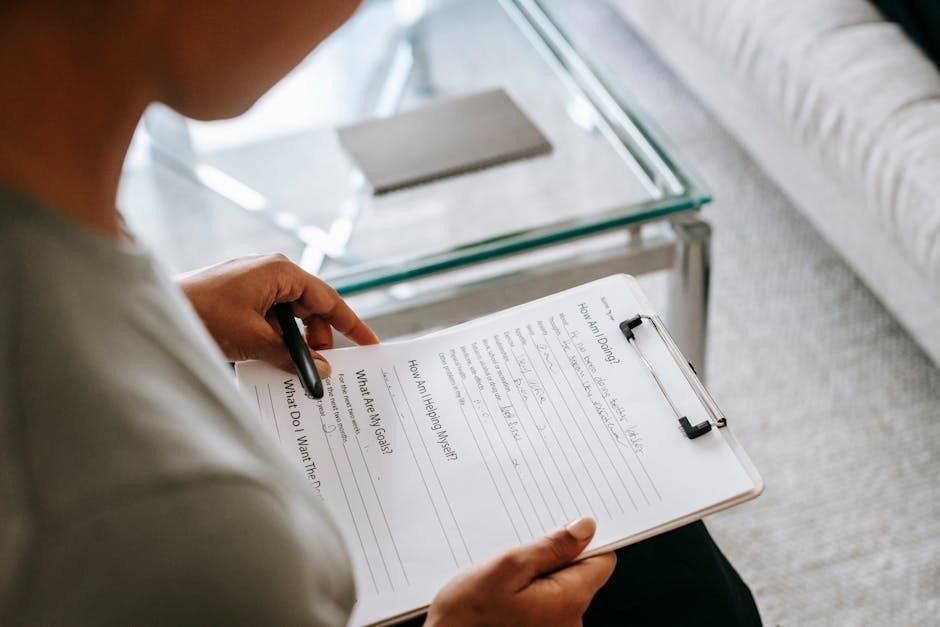RBT session notes are detailed records documenting client activities, interventions, and progress during therapy sessions. They capture objective behaviors, track development, and guide future interventions effectively.
What are RBT Session Notes?
RBT session notes are detailed documentation of activities, interventions, and client responses during therapy sessions. These notes are written by Registered Behavior Technicians (RBTs) and include objective descriptions of behaviors, progress toward treatment goals, and any challenges or breakthroughs observed. They serve as a record of what occurred during the session, providing a clear and measurable account of the client’s development. Session notes are essential for tracking progress, informing future interventions, and ensuring continuity of care. They also play a critical role in insurance reimbursement and legal compliance, as they provide a professional and standardized record of therapy sessions. By capturing specific details, RBT session notes help guide treatment decisions and ensure client progress is accurately documented.

Why RBT Session Notes Matter
RBT session notes are crucial for tracking client progress, ensuring accountability, and maintaining clear communication among treatment teams. They provide a detailed record of each therapy session, documenting interventions, client responses, and developmental milestones. This documentation is essential for insurance reimbursement, as it demonstrates the effectiveness and necessity of ongoing treatment. Moreover, session notes protect both clients and professionals by serving as a legal record of services provided. They also facilitate consistency in therapy approaches and help in training new RBTs by offering examples of effective documentation. Ultimately, RBT session notes are vital for delivering high-quality, individualized care and upholding professional standards in ABA therapy.

Key Elements of RBT Session Notes
Key elements include objective behavior descriptions, client progress tracking, and detailed interventions. These components ensure comprehensive documentation, guiding future sessions and treatment plans effectively.
Objective Behavior Descriptions

Objective behavior descriptions in RBT session notes focus on observable and measurable actions, avoiding personal opinions. For example, noting “The client initiated three requests using the PECS system” provides clear, factual information. This approach ensures consistency and accuracy in tracking progress. By documenting specific behaviors, such as “The client engaged in joint attention for 5 minutes,” professionals can monitor development over time. These descriptions are essential for creating effective treatment plans and facilitating communication among team members. Using precise language helps in understanding the client’s responses to interventions, making it easier to assess the effectiveness of strategies and make necessary adjustments. Objective descriptions form the foundation of reliable and actionable session notes.
Client Progress Tracking
Client progress tracking in RBT session notes involves documenting measurable advancements toward treatment goals. This includes noting increases in task completion, reductions in problem behaviors, or improvements in skill acquisition; For example, recording “Client independently initiated 4 out of 5 transitions” highlights progress in self-management. Data collection, such as accuracy rates or response times, provides a clear picture of development. Tracking progress helps identify patterns, celebrate milestones, and adjust interventions as needed. Regular updates ensure continuity in care and allow for informed decision-making. By maintaining a detailed record of advancements, RBTs can demonstrate the effectiveness of interventions and support long-term client success. This systematic approach ensures accountability and fosters collaboration among team members.
Interventions and Responses
Interventions and responses documented in RBT session notes detail the strategies implemented during therapy and the client’s reactions to them. This includes descriptions of prompts, reinforcements, and behavior modification techniques. For example, “The RBT used a first-then visual schedule to transition the client, resulting in immediate compliance without tantrums.” Recording client responses, such as “Client independently requested items using the PECS system during snack time,” provides insight into intervention effectiveness. These notes also capture challenging behaviors and the interventions used to address them, like “Client displayed hand flapping during loud noises; deep pressure was applied, and client calmed within 30 seconds.” Documenting interventions and responses helps refine treatment plans and ensures consistency across sessions. This data-driven approach supports measurable outcomes and informed decision-making for future interventions.

Structure of RBT Session Notes
RBT session notes follow a structured format, often using SOAP notes (Subjective, Objective, Assessment, Plan) or templates to organize details like goals, interventions, and client responses.
SOAP Note Format (Subjective, Objective, Assessment, Plan)
The SOAP note format is a widely used structure for RBT session notes, consisting of four sections: Subjective, Objective, Assessment, and Plan. The Subjective section includes client-reported information or observations of their mood and behavior. The Objective section documents measurable data, such as task completion rates or specific behaviors observed. The Assessment synthesizes the information to identify progress, challenges, or emerging patterns. Finally, the Plan outlines the next steps, including adjustments to interventions or goals. This format ensures clarity, organization, and continuity in documentation, making it easier to track client progress and communicate with other professionals. Many RBTs use templates or tools, like ABA note generators, to simplify the SOAP note process and maintain consistency.
Session Note Templates
Session note templates provide a structured format for documenting RBT sessions, ensuring consistency and thoroughness. These templates typically include sections for goals addressed, interventions implemented, client responses, and progress made. They often follow the SOAP note format, with areas for subjective observations, objective data, assessment, and plans for future sessions. Many templates are available in PDF format, offering ease of use and customization. Examples include pre-designed SOAP note templates, progress tracking sheets, and behavior intervention checklists. By using templates, RBTs can save time, reduce errors, and maintain a clear record of client progress. Templates also help ensure compliance with professional standards and insurance requirements, making them an invaluable tool for effective documentation. Popular resources for RBT session note templates include online marketplaces like Teachers Pay Teachers and ABA-specific websites. These templates can be tailored to meet individual client needs and organizational requirements. They promote consistency and clarity in documentation, which is critical for tracking progress and informing future interventions. Additionally, templates help ensure that all necessary details are captured, reducing the risk of incomplete or inaccurate notes. Overall, session note templates are a practical solution for RBTs aiming to enhance the quality and efficiency of their documentation practices.
Examples of Session Note Organization
Session notes can be organized using the SOAP note format, which stands for Subjective, Objective, Assessment, and Plan. Subjective sections include client-reported information or observations, while Objective sections detail specific behaviors, data, and interventions. The Assessment summarizes progress and identifies challenges, and the Plan outlines next steps. Many templates and examples, such as those found in PDF formats, demonstrate this structure. For instance, a session note might include sections for goals addressed, interventions used, client responses, and progress toward objectives. Examples often feature tables or checklists to track behavior frequency or task completion. Visual supports, like graphs, may also be included to illustrate trends over time. This organized approach ensures clarity, making it easier to review and share information with teams or stakeholders. Proper organization is key to effective documentation and client care.

Examples of RBT Session Notes
Examples of RBT session notes include detailed records of client engagement, specific interventions, and measurable progress, providing clear insights into therapy outcomes and client development.
Sample Session Note 1: Client Engagement and Progress
The client demonstrated increased engagement during the session, actively participating in joint attention activities and independently initiating tacts of objects. The client used the PECS system to request preferred items, showing improved independence. Data indicated consistent progress toward communication goals, with a 30% increase in spontaneous requests compared to previous sessions. Interventions included gradual prompt fading across multiple programs, which the client responded to appropriately. No challenging behaviors were observed during transitions or task demands. The client maintained a calm demeanor throughout the session and displayed interest in interactive play. Progress highlights include independent engagement in circle time and successful use of augmentative communication tools. These observations suggest strong foundational skills and readiness for advancing communication objectives in future sessions.
Sample Session Note 2: Challenges and Breakthroughs
Objective: The client initially displayed non-compliant behavior during transitions, refusing to engage in the next task. However, after implementing a visual schedule and offering choices, the client transitioned successfully with minimal prompting. Breakthrough: The client independently used the PECS system to request preferred items, demonstrating improved communication skills. Challenges: The client required 3 prompts to initiate tacts of objects but showed reduced resistance to task demands. Assessment: Progress was observed in the client’s ability to communicate effectively, though consistency in task engagement remains a goal. Plan: Continue fading prompts during transitions and increase opportunities for independent communication. Document frequency of spontaneous requests using the PECS system in future sessions.
Sample Session Note 3: Use of PECS System
Objective: The client demonstrated increased independence in using the PECS system to communicate. During the session, the client spontaneously requested preferred items (e.g., toys, snacks) using the PECS system without prompting. Breakthrough: The client initiated 8 independent requests, a notable improvement from previous sessions. Challenges: The client required verbal prompts to repair communication when initial requests were denied. Assessment: The client’s ability to use the PECS system effectively is progressing well, with clear understanding of its purpose. Plan: Continue to expand the client’s vocabulary by introducing new symbols and gradually phase out verbal prompts for repairs. Monitor and document the frequency of spontaneous requests in future sessions to track progress.

Best Practices for Writing RBT Session Notes
- Be objective, focusing on observable behaviors and measurable outcomes.
- Use clear, concise language to ensure understanding and compliance with professional standards.
- Document specific details about interventions, client responses, and progress toward goals.
- Incorporate data to support observations and guide future session plans effectively.
Being Objective vs. Subjective
Writing RBT session notes requires a clear distinction between objective and subjective observations. Objective notes focus on measurable, observable behaviors and facts, such as specific actions, responses, or data points. For example, “The client engaged in circle time for 15 minutes without prompts” is an objective statement. Subjective notes, in contrast, include personal opinions or interpretations, like “The client seemed happy today,” which lack concrete evidence.
- Objective writing is essential for accuracy, as it provides clear, unbiased information about the session.
- Subjective interpretations can lead to miscommunication and should be avoided in professional documentation.
- Always prioritize observable behaviors and measurable outcomes to ensure reliable and actionable notes.
By maintaining an objective tone, RBTs ensure that session notes are professional, consistent, and focused on client progress.
Documenting Specific Details
Documenting specific details in RBT session notes is crucial for tracking client progress and informing future interventions. Include concrete examples of behaviors observed, such as the number of prompts required, specific tasks completed, and client responses. For instance, note if a client independently used the PECS system to request items or required hand-over-hand assistance. Avoid vague statements like “made progress” and instead provide measurable outcomes, such as “client initiated 3 out of 5 requests independently.”
- Specify interventions used and their effectiveness.
- Record data on target behaviors and skill acquisition.
- Include any challenges or breakthroughs observed during the session.
These details ensure clarity and provide a comprehensive understanding of the client’s development over time.
Using Data to Support Observations
Using data to support observations in RBT session notes ensures objective and actionable documentation. Include specific metrics, such as response times, correct answers, or instances of target behaviors, to validate progress or challenges. For example, noting “client achieved 8 out of 10 independent correct responses during tact training” provides clear, measurable evidence of skill acquisition. Data also helps track trends over time, enabling informed decisions for future sessions. Use graphs or charts to visualize progress, making it easier to communicate with stakeholders. By integrating data, session notes become a powerful tool for monitoring client development and adjusting interventions effectively. This approach ensures transparency and accountability in ABA therapy practices.


Tools and Resources for RBT Session Notes
- ABA Notes Generator: Streamlines note creation with pre-built templates.
- Session Note Templates: Provides structured formats for consistency.
- PDF Examples: Offers downloadable samples for reference.
- Cheat Sheets: Guides technicians in documenting effectively.
ABA Notes Generator
An ABA Notes Generator is a powerful tool designed to simplify the documentation process for Registered Behavior Technicians (RBTs) and Board Certified Behavior Analysts (BCBAs). This innovative software automatically generates session notes based on inputted data, reducing manual effort and saving time. With pre-built templates and customizable options, it ensures consistency and accuracy in documenting client progress, interventions, and responses. The generator supports SOAP note formats, allowing users to easily organize information under Subjective, Objective, Assessment, and Plan sections. Additionally, it provides features for tracking specific behaviors, goals, and interventions, making it easier to monitor client development over time. By streamlining the documentation process, the ABA Notes Generator helps professionals focus more on delivering high-quality therapy sessions while maintaining professional and insurance reimbursement standards.
Session Note Templates and Cheat Sheets
Session note templates and cheat sheets are invaluable resources for RBTs to ensure consistency and efficiency in documentation. These tools provide structured formats for organizing session details, such as client goals, interventions, and progress. Templates often include sections for objective behavior descriptions, data collection, and next steps, helping RBTs maintain clarity and professionalism. Cheat sheets offer quick reminders of key elements to include, such as measurable outcomes, specific interventions, and client responses. By using these resources, RBTs can save time and focus on delivering high-quality care while meeting professional standards. Additionally, templates and cheat sheets help ensure compliance with insurance reimbursement requirements and HIPAA guidelines, making them essential for effective and ethical documentation practices in ABA therapy settings.
PDF Examples of Session Notes
PDF examples of session notes provide clear, structured templates for RBTs to document therapy sessions effectively. These examples often include sections for client goals, interventions, and progress, ensuring consistency and professionalism. Many PDF templates are available online, offering customizable formats that align with SOAP note standards. They include spaces for objective behavior descriptions, measurable outcomes, and specific interventions, helping RBTs maintain thorough and organized records. Examples also highlight proper formatting for subjective, objective, assessment, and plan sections. Platforms like Teachers Pay Teachers and Etsy offer downloadable PDF templates designed for ABA therapy. These resources are invaluable for RBTs aiming to meet insurance reimbursement requirements and professional documentation standards. By using these examples, RBTs can ensure their session notes are clear, concise, and compliant with legal and ethical guidelines.

Legal and Ethical Considerations
Session notes must adhere to HIPAA compliance and maintain client confidentiality. Ethical standards require accurate, unbiased documentation, ensuring professionalism and transparency in all records.
Confidentiality and HIPAA Compliance
Maintaining confidentiality is a critical legal and ethical obligation for RBTs when documenting session notes. All notes must comply with HIPAA regulations to protect client privacy.
Session notes should be stored securely, whether digitally or in physical files, to prevent unauthorized access. Digital notes should be encrypted, and physical notes kept in locked areas.
Only authorized personnel should have access to these records. RBTs must ensure that client information is not shared without proper consent, adhering to strict confidentiality standards.
Violating HIPAA guidelines can result in severe legal consequences, including fines and loss of certification. Therefore, RBTs must remain vigilant in safeguarding client data at all times.
By following these guidelines, RBTs uphold professional integrity and ensure client trust, which is essential for effective therapy and ethical practice.
Insurance Reimbursement Requirements
Insurance reimbursement for ABA therapy sessions often depends on accurate and detailed RBT session notes. These notes must clearly outline the goals addressed, interventions implemented, and the client’s response to these interventions.
Insurance companies require specific documentation to approve reimbursement, including measurable progress, objective data, and a clear connection between the session activities and treatment goals.
RBTs must ensure that session notes are professional, concise, and free from subjective opinions. They should include details such as the duration of the session, tasks performed, and any notable behaviors or achievements.
Failure to meet these documentation standards can result in delayed or denied reimbursement; Therefore, RBTs must adhere to these requirements to ensure seamless reimbursement processes.
By maintaining thorough and compliant session notes, RBTs not only fulfill insurance requirements but also uphold professional standards of documentation.
Professional Standards for Documentation
Professional standards for RBT session notes require accuracy, clarity, and adherence to established guidelines. These notes must be objective, avoiding personal opinions, and focus on observable behaviors and measurable outcomes. RBTs should document interventions, client responses, and progress toward goals, ensuring data-driven observations. Session notes must be completed during or immediately after the session to maintain reliability. They should include details such as the date, time, location, and specific activities conducted. Adherence to these standards ensures consistency, accountability, and compliance with professional and legal requirements. Proper documentation also facilitates clear communication among team members and supports continuity of care. Failure to meet these standards can lead to legal or compliance issues, making it essential for RBTs to uphold these professional documentation practices.
Effective RBT session notes are crucial for tracking progress, guiding interventions, and maintaining professional standards. They ensure clear communication and continuity of care.
Importance of Effective Session Notes
Effective session notes are vital for tracking client progress, ensuring continuity of care, and maintaining accountability in ABA therapy. They provide a clear record of interventions, responses, and advancements toward treatment goals, enabling data-driven decision-making. Accurate documentation helps assess the effectiveness of strategies and identify areas for adjustment. Additionally, session notes facilitate communication among team members, ensuring consistent approaches and aligned objectives. They also serve as a historical reference for the client’s journey, aiding in long-term planning and evaluation. Properly written notes are essential for legal and ethical compliance, including HIPAA requirements and insurance reimbursement. By capturing objective, measurable data, session notes enhance the quality of care and contribute to better client outcomes. They are a cornerstone of professional practice in ABA therapy, ensuring transparency and accountability in every session.
Final Tips for Mastering RBT Session Notes
Mastering RBT session notes requires consistency, attention to detail, and a commitment to objectivity. Always prioritize clear, concise language, avoiding subjective interpretations. Use specific examples and measurable data to support observations, ensuring accuracy and reliability. Regularly review and update notes to reflect client progress and changes in treatment plans. Maintain confidentiality and adhere to HIPAA guidelines to protect client privacy. Leverage tools like ABA note generators and templates to streamline documentation while ensuring compliance with professional standards. Finally, seek feedback from supervisors or BCBAs to refine your documentation skills and ensure alignment with best practices. By following these tips, you can enhance the quality of your session notes, ultimately improving client outcomes and upholding professional integrity.


